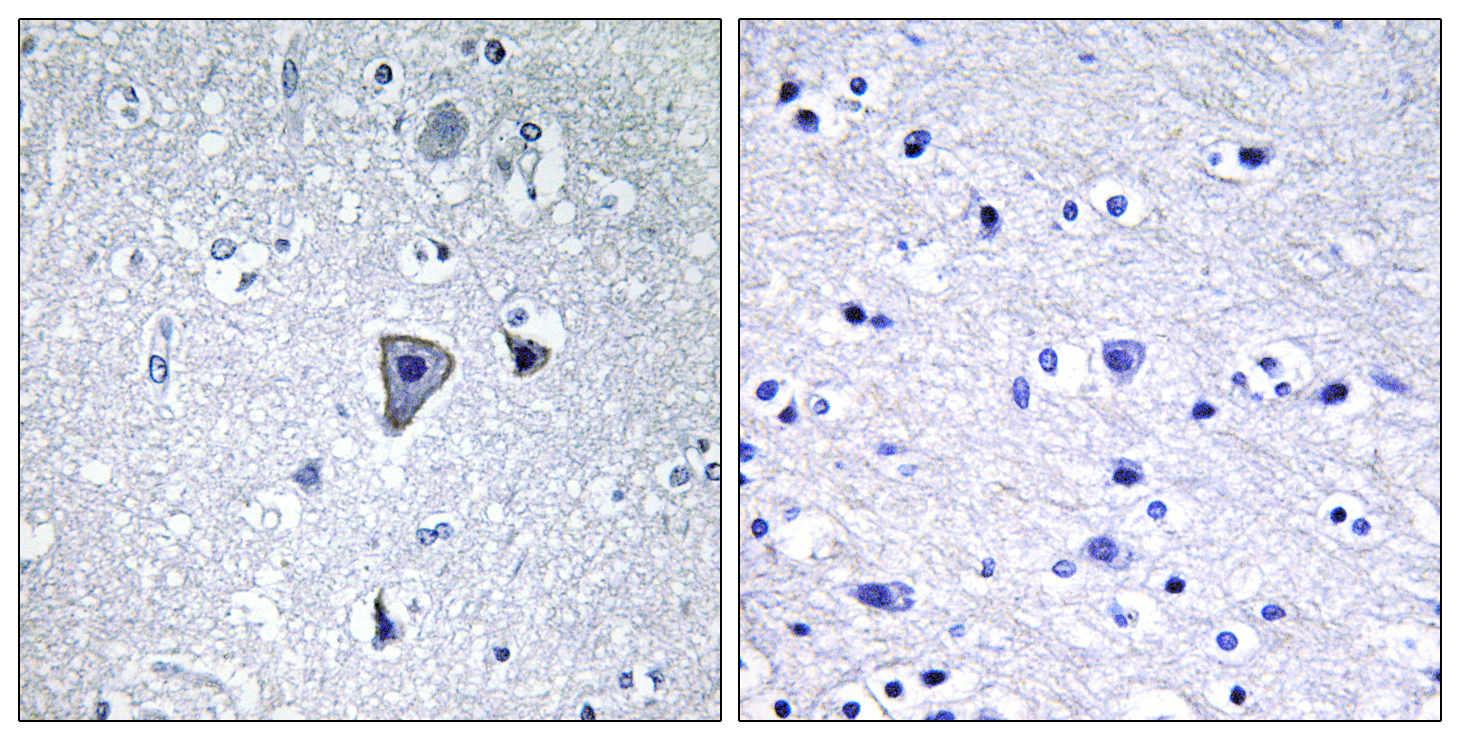mGluR1 Polyclonal Antibody
- Catalog No.:YT2741
- Applications:IHC;IF;ELISA
- Reactivity:Human;Mouse;Rat
- Target:
- mGluR1
- Fields:
- >>Calcium signaling pathway;>>FoxO signaling pathway;>>Phospholipase D signaling pathway;>>Neuroactive ligand-receptor interaction;>>Gap junction;>>Long-term potentiation;>>Retrograde endocannabinoid signaling;>>Glutamatergic synapse;>>Long-term depression;>>Taste transduction;>>Estrogen signaling pathway;>>Spinocerebellar ataxia;>>Pathways of neurodegeneration - multiple diseases
- Gene Name:
- GRM1
- Protein Name:
- Metabotropic glutamate receptor 1
- Human Gene Id:
- 2911
- Human Swiss Prot No:
- Q13255
- Mouse Gene Id:
- 14816
- Mouse Swiss Prot No:
- P97772
- Rat Gene Id:
- 24414
- Rat Swiss Prot No:
- P23385
- Immunogen:
- The antiserum was produced against synthesized peptide derived from human GRM1. AA range:251-300
- Specificity:
- mGluR1 Polyclonal Antibody detects endogenous levels of mGluR1 protein.
- Formulation:
- Liquid in PBS containing 50% glycerol, 0.5% BSA and 0.02% sodium azide.
- Source:
- Polyclonal, Rabbit,IgG
- Dilution:
- IHC 1:100 - 1:300. ELISA: 1:5000.. IF 1:50-200
- Purification:
- The antibody was affinity-purified from rabbit antiserum by affinity-chromatography using epitope-specific immunogen.
- Concentration:
- 1 mg/ml
- Storage Stability:
- -15°C to -25°C/1 year(Do not lower than -25°C)
- Other Name:
- GRM1;GPRC1A;MGLUR1;Metabotropic glutamate receptor 1;mGluR1
- Molecular Weight(Da):
- 132kD
- Background:
- glutamate metabotropic receptor 1(GRM1) Homo sapiens This gene encodes a metabotropic glutamate receptor that functions by activating phospholipase C. L-glutamate is the major excitatory neurotransmitter in the central nervous system and activates both ionotropic and metabotropic glutamate receptors. Glutamatergic neurotransmission is involved in most aspects of normal brain function and can be perturbed in many neuropathologic conditions. The canonical alpha isoform of the encoded protein is a disulfide-linked homodimer whose activity is mediated by a G-protein-coupled phosphatidylinositol-calcium second messenger system. This gene may be associated with many disease states, including schizophrenia, bipolar disorder, depression, and breast cancer. Alternative splicing results in multiple transcript variants encoding different isoforms. [provided by RefSeq, May 2013],
- Function:
- function:Receptor for glutamate. The activity of this receptor is mediated by a G-protein that activates a phosphatidylinositol-calcium second messenger system. May participate in the central action of glutamate in the CNS, such as long-term potentiation in the hippocampus and long-term depression in the cerebellum.,similarity:Belongs to the G-protein coupled receptor 3 family.,subunit:Homodimer; disulfide-linked. The PPXXF motif binds HOMER1, HOMER2 and HOMER3. Interacts with SIAH1, RYR1, RYR2, ITPR1, SHANK1, SHANK3 and GRASP.,
- Subcellular Location:
- Cell membrane ; Multi-pass membrane protein .
- Expression:
- Detected in brain.
- June 19-2018
- WESTERN IMMUNOBLOTTING PROTOCOL
- June 19-2018
- IMMUNOHISTOCHEMISTRY-PARAFFIN PROTOCOL
- June 19-2018
- IMMUNOFLUORESCENCE PROTOCOL
- September 08-2020
- FLOW-CYTOMEYRT-PROTOCOL
- May 20-2022
- Cell-Based ELISA│解您多样本WB检测之困扰
- July 13-2018
- CELL-BASED-ELISA-PROTOCOL-FOR-ACETYL-PROTEIN
- July 13-2018
- CELL-BASED-ELISA-PROTOCOL-FOR-PHOSPHO-PROTEIN
- July 13-2018
- Antibody-FAQs
- Products Images

- Immunohistochemistry analysis of paraffin-embedded human brain tissue, using GRM1 Antibody. The picture on the right is blocked with the synthesized peptide.



